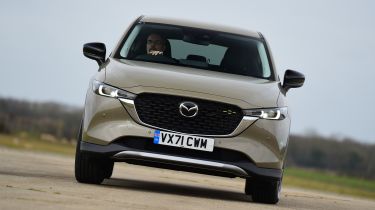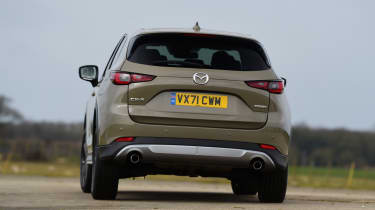Mazda CX-5 review - Engines, performance and drive
The Mazda CX-5 is fun to drive for an SUV, while improved refinement and comfort make for a capable all-rounder

Mazda says this second-generation CX-5 features a “fully revised body structure”, using the firm’s SkyActiv underpinnings. Changes include a 15 per cent improvement in the body’s torsional rigidity, which has enabled engineers to tweak the suspension to offer more comfort, apparently without compromising the CX-5’s trademark engaging dynamics.
All Mazdas offer an agile and fun driving experience relative to their competitors, and the CX-5 is no different. For a tall and fairly heavy SUV, its direct steering, strong grip levels and impressive agility makes cars like the VW Tiguan look like lumbering beasts. You can tell from the way the CX-5 drives that it was developed by the same company who build the MX-5 sports car.
The CX-5’s steering is very communicative. It’s heavier than you'll find in a Skoda Kodiaq or VW Tiguan, but it gently ripples with information – not to the point where it becomes taxing, but just enough to offer you a good connection with the front tyres.
It’s this that gives the Mazda its dynamic edge. The effect of the G-Vectoring Control is so subtle that it’s difficult to feel it working in truth, but the CX-5 certainly turns in sweetly. There’s plenty of grip to lean on, while the suspension takes up a nice amount of roll but controls body movement well.
Used - available now
During the recent facelift, the CX-5 received updated damping to help make it feel more composed than some rivals, with only a little more body-roll as a trade-off. However, the difference is still marginal at normal speeds, and although this makes it an enjoyable car to drive, around town and on a cruise there’s not much in it.
For the 2023 update, the CX-5 hybrid model will feature a series of drivetrain modes which can be adjusted to suit a particular road surface. There’s even an ‘off-road’ mode which Mazda claims makes the CX-5 “feel more natural on unmade and slippery surfaces”, such as gravel.
0-62mph acceleration and top speed
The CX-5’s two four-cylinder engines are both carried over from the previous CX-5, with several revisions to improve refinement, response and fuel efficiency. For instance, every new petrol-powered CX-5 comes with 24V mild-hybrid technology and cylinder deactivation, which Mazda says this has reduced average CO2 emissions across the range by 9g/km.
The 2.2-litre diesel is a strong and flexible unit, with gutsy torque delivery and a broad spread of power resulting in even the 148bhp version feeling reasonably quick (although this version is no longer available on the price list).
Other advances include Mazda's G-Vectoring Control, which adjusts engine torque on the way into corners to help improve turn-in response, while a newly designed pin that secures the piston to the connecting rod in the engine helps dampen vibration and boost refinement. This dynamic damper cuts engine noise noticeably. The CX-5 is quiet at idle and more hushed on the move, with the extra torque combining with this refinement to deliver a relaxing drive. The petrol feels much more composed in the bends than the more nose-heavy diesel model as well.
When we tested the 148bhp CX-5 against a 148bhp Skoda Kodiaq and VW Tiguan, the Mazda's punchier engine gave it an advantage in-gear; it accelerated from 30-50mph in fourth and 50-70mph in sixth well ahead of its rivals, in 5.4 and 10.0 seconds respectively. The free-shifting but precise six-speed manual box helped it sprint from 0-60mph the fastest, in 9.1 seconds.
The original 173bhp engine was replaced by a more powerful 181bhp oilburner in 2018, but the effect of its extra power over the 148bhp engine is mitigated by the increased weight if you opt for four-wheel drive. Still, whichever output you go for refinement is very good, with only a bit of a clatter on start-up which becomes a muted hum on the move.
The 2.0-litre petrol engine is naturally aspirated, unlike most rivals which are turbocharged. But it doesn’t feel as strained as you might expect. With a respectable 213Nm of torque and 163bhp, it manages the 0-62mph sprint in 10.7 seconds.
The power delivery across the rev range is decent, but compared to turbocharged offerings from the VW Group you’ll have to work the petrol engine a bit harder. On the bright side this does mean you get to utilise the excellent shift of the manual gearbox more often – we’d recommend choosing the manual because while the six-speed automatic is okay, it’s a little slow to shift and can hold on to gears for too long. Volkswagen’s DSG automatic is much better in this segment.
Despite its extra 28bhp and 50Nm of torque, the 2.5-litre petrol version only manages a 9.5 second time from 0-62mph – almost two seconds off a comparable Skoda Karoq 2.0-litre TSI. We found this version of the CX-5 to be a little unrefined, too, particularly when pressing on. It definitely suits a more relaxed driving style where the powertrain isn't overly stressed.















